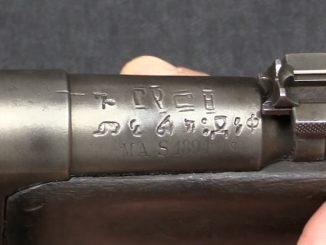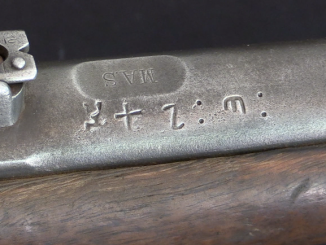Century International Arms has imported a quantity of Ethiopian ammunition, and asked me to do a video on it. So, I have a three-part evaluation here: appearance and packaging, live fire testing (including velocity and consistency), and teardown and bullet weight consistency. This ammunition was produced (as best I can tell) at the Emperor Haile Selassie Ammunition Factory, established with Czech technical aid in the late 1940s in Addis Ababa. This ammunition is all headstamped 1977, made for a variety of American surplus rifles and machine guns acquired by Ethiopia including the M1 Garand, M1917 and M1919 machine guns, and M1918A2 BAR. I received this ammunition packaged in 15-round loose boxes as well as in M1 Garand en bloc clips and bandoliers.
Velocity:
I tested velocity using a .30-06 M1917 Enfield rifle (barrel length 26 inches). Measurements were taken at 10 feet from the muzzle, with a sample size of 15 rounds fired. I found an average velocity of 2998 fps, extreme spread of 90 fps (max 3031, min 2941), and standard deviation of 25.36 fps. None of the rounds exhibited any unusual behavior when fired, although the velocity I measured was substantially higher than the American M2 spec which I would have expected in a flat base 150 grain loading. Note: I tested ammunition from the 15 round boxes, and no form the Garand bandoliers. I did not test this in a Garand rifle, and cannot comment on the bolt velocity it produces therein.
Bullets:
I tested the weight of 10 bullets using a calibrated Lyman electronic scale. I found an average weight of 150.7 grains, extreme spread of 1.6 grains (max 151.6 gr, min 150.0 gr), and standard deviation of 0.52 grains. Bullet construction is flat base with an open base, lead core, and gilding metal over steel jacket (these bullets do attract a magnet).
Century advertises this ammunition as using corrosive primers, and I took them at their word and did not test for corrosivity.
Raw data:
Velocities (fps): 2955, 3015, 3028, 2993, 2992, 2976, 3009, 3017, 3020, 2995, 2941, 3001, 3031, 2994, 3007
Bullet weights (grains): 151.0, 150.7, 150.1, 150.5, 150.0, 151.6, 150.9, 150.7, 150.4, 151.4




Good reason for an adjustable gas plug on a Garand; better safe than sorry.
I appreciate the overcharged powder load in that you might get a flatter trajectory but that would require a serious sight readjustment, right? I need not say anything about penetration of trees (or stuffed furniture), though someone has a more consistent testing method with pine planks of a particular thickness. The number of people who think they can use drywall and overstuffed file cabinets as cover is quite astonishing. On the flip side, how much powder was wasted as muzzle flash? I do recall that the M44 carbine (not M4) had lots of flash (to the point that anything near the muzzle got burned) and a bang that would certainly wake up any sleeping person who wasn’t totally deaf in a hundred meter radius. I could be wrong.
200 fps increase in muzzle velocity will not make huge increase in penetration, although it of course could be critical in some edge cases. I don’t know how many trained soldiers would actually try to use drywall as cover. Usually soldiers are taught that even a normal structural brick wall or exterior wall of a normal residential house will not stop rifle caliber bullets reliably. Such wall should always be reinforced with sandbags (or steel plates, when available) even for a rudimentary fortification against small arms fire. If 12.7mm heavy MG bullet resistance is required, several layers of sandbags is required. If you want better resistance (14.5mm upwards), you should probably start with a reinforced concrete or stone masonry structure. In the latter case soft mineral stones (e.g. sandstone or limestone) are significantly less protective than harder ones (e.g. granite).
Having been a lifelong reloader I would have liked to see the spent cartridges and the primer in particular. I always examine the primer after firing a suspect load. Keep up the good work.
Why do you inspect the primer?
Perhaps there was a different primer compound or something else was going on within the cartridge case.
You inspect the primer for signs of bulging or blow out. Because a primer is in the case with just a friction fit it usually is the first part to show signs of over pressure. Next would be the sides of the case for signs of splitting. I usually inspect some of my spent cases after shooting a few magazines just to make sure the ammo/firearm is running correctly.
It’s always a good idea to check for over pressure when something odd happens. Somewhere in my foggy memory IIRC the M2 ball round was downloaded during development. Some rounds were going beyond the safe area down range and being unable to extend the range, the ammo was lightened up. The case may be able to withstand higher pressures, the Garands may not.
I agree, lets see primer.
wish the 8MM would have tested as well as this stuff
Really enjoy these ammo evaluations; looking forward to more. BTW, love that M1917!
Cheers
The presences of both 1970 and 1978 dates seems likely due to the differences between the Ethiopian and Gregorian calendars. Notice that on the ammo can the 1970 date is adjacent to writing in Amharic whilst the 1978 date has english writing on the same line.
https://en.wikipedia.org/wiki/Ethiopian_calendar
The dates may be the packing date not production date
Ian, you should also weight the powder loads of the cartridges you dissambled. This would be useful to put velocity variation in perspective.
By the way, these bullets are not hollow base. They are simple full metal jacket. The manufacturing process is such that the lead core does not go down to the outside of the jacket.